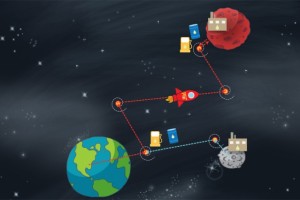As NASA gears up for a mission to Mars, planning a route to the Red Planet is important. Now, researchers have found that to save on weight and have concluded that a detour to the moon is the best route to Mars. Previous studies have suggested that lunar soil and water ice in certain craters of the moon could potentially be mined and converted to fuel. With the assumption that this tech exists at the time of a Mars mission, taking a detour to the moon to refuel actually reduces the mass of a mission upon launch by a staggering 68 percent.
The researchers developed a model to determine the best route to Mars, assuming the availability of resources and fuel-generating infrastructure on the moon. Based on their calculations, they found the optimal route to Mars in order to minimize the mass that would have to be launched from Earth. The most mass-efficient path actually involves launching a crew from Earth with just enough fuel to get into orbit around Earth. A fuel-producing plant on the surface of the moon would then launch tankers of fuel into space, where they would enter gravitational orbit. The tankers would be picked up by the Mars-bound crew, which would then head to a nearby fueling station to gas up before heading to Mars. “This is completely against the established common wisdom of how to go to Mars, which is a straight shot to Mars, carry everything with you,” said Olivier de Weck, one of the researchers, in a news release. “The idea of taking a detour into the lunar system, it’s very unintuitive, but from an optimal network and big picture view, this could be very affordable in the long term, because you don’t have to ship everything from Earth.” The findings could mean that a network of “stops” before Mars is the best way to reach the Red Planet. With further study, researchers may be able to determine the most cost-effective and safest method to travel to Mars.
In the past, space exploration programs have adopted two main strategies in supplying mission crews with resources, a carry-along approach, where all vehicles and resources travel with the crew at all times, as on the Apollo missions to the moon and a “resupply strategy,” in which resources are replenished regularly, such as by spaceflights to the International Space Station. However, as humans explore beyond Earth’s orbit, such strategies may not be sustainable, as de Weck and Ishimatsu write: “As budgets are constrained and destinations are far away from home, a well-planned logistics strategy becomes imperative.” “Our ultimate goal is to colonize Mars and to establish a permanent, self-sustainable human presence there,” said Takuto Ishimatsu, one of the researchers. “However, equally important, I believe that we need to ‘pave a road’ in space so that we can travel between planetary bodies in an affordable way.”
The team proposes that missions to Mars and other distant destinations may benefit from a supply strategy that hinges on “in-situ resource utilization”, the idea that resources such as fuel, and provisions such as water and oxygen, may be produced and collected along the route of space exploration. Materials produced in space would replace those that would otherwise be transported from Earth. For example, water ice which could potentially be mined and processed into rocket fuel has been found on both Mars and the moon. Ishimatsu says the research demonstrates the importance of establishing a resource-producing infrastructure in space. He emphasizes that such infrastructure may not be necessary for a first trip to Mars. But a resource network in space would enable humans to make the journey repeatedly in a sustainable way.
“Our ultimate goal is to colonize Mars and to establish a permanent, self-sustainable human presence there,” Ishimatsu says. “However, equally importantly, I believe that we need to ‘pave a road’ in space so that we can travel between planetary bodies in an affordable way.” “The optimization suggests that the moon could play a major role in getting us to Mars repeatedly and sustainably,” de Weck adds. “People have hinted at that before, but we think this is the first definitive paper that shows mathematically why that’s the right answer.”
William Gerstenmaier, associate administrator for human exploration and operations at NASA, says understanding what resources may be available, both along the way to Mars and once there, is “essential to sustainable human presence beyond low-Earth orbit.” “The paper shows clearly that leveraging water and other valuable in-space resources will lower the cost for human exploration of the solar system,” says Gerstenmaier, who was not involved in the research. “NASA had previously planned on using Mars resources to reduce propellant needs at Mars. This study, along with others, is showing the potential advantages of using lunar resources as well.”
For more information please visit: www.mit.edu

